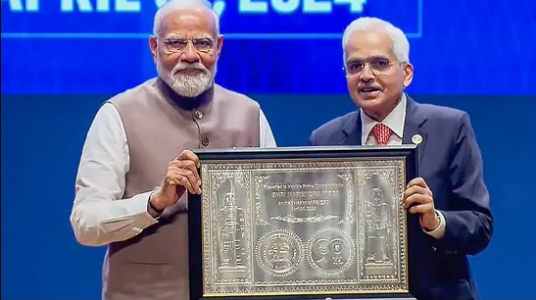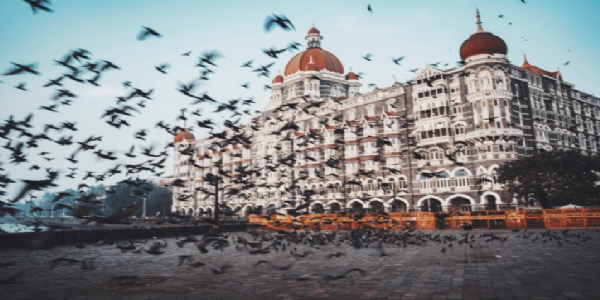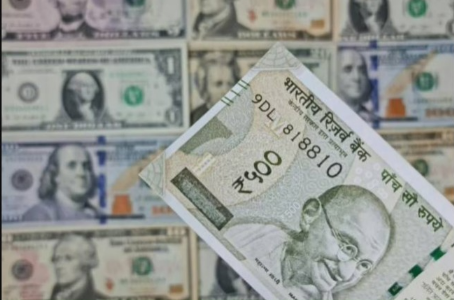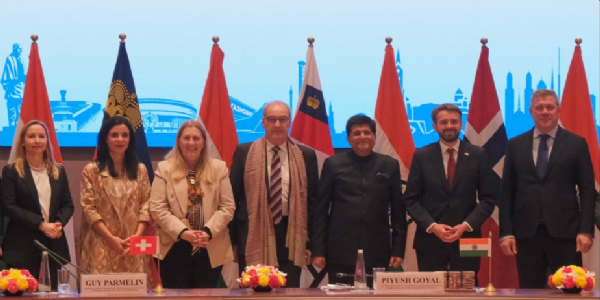After UPI, can the Digital rupee and rupee settlement for International trade be the Game changer?
35 countries are keen to start settling their trades in Rupee - which simply means that in times to come, demand for INR will remain consistent, thus giving strength to the currency.
Total Views | 574
Can the US Dollar’s hegemony be broken?
Can the Indian rupee be universally acceptable?
Can the Indian rupee ever be the reserve currency?
Subhashit: अधमा धनमिच्छन्ति धनं मानं च मध्यमाः । उत्तमा मानमिच्छन्ति मानो हि महताम् धनम् ॥
Meaning: Lowly people desire wealth - over respect, average people desire wealth and respect, the great people desire respect - over wealth, for respect is the wealth of the great!
As per Vedic Philosophy, Artha or money or Wealth is essential and forms one of the four objectives of Human life for well-being. These four ultimate goals are compositely called Purushartha.
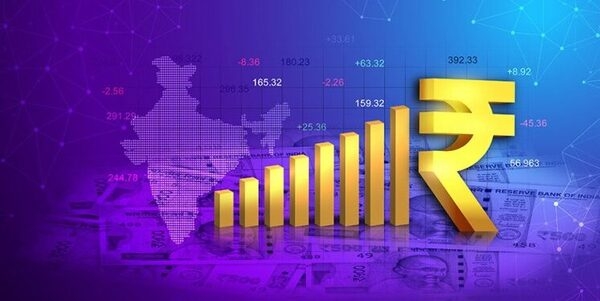
However, the essence of earning money or acquiring wealth by an individual, by a household, by a country is not exploitation, subjugation or oppression but ensuring Artha is available sufficiently for self and sufficient to enable and help others for their well-being, acquired only by pursuing Dharma and through ethical and honest ways.
Delving in & detailing the Past
In 1947, at the time of India's independence, the world was divided and driven by two diametrically opposite methodologies - Capitalism and communism. However, India created and chose a third way- a non–aligned way of self-reliance and Universal Well-being.
It started rebuilding the economy bit by bit through the Green revolution, and the White revolution and the criticality of exports were thought through.
Despite the intent, the outcome was scant, especially in the case of global trade and exports. The country that once manufactured or supplied the world through exports in the form ~30% of the global output (just three centuries back), in the 1950s was still struggling to find its feet in the international market.
Back then, it was being driven by Britishers who left the country officially, yet retained control over India as a market and determined to whom it exported. The job was delegated and efficiently executed by the cronies of Britishers who stayed back, those who were not white in colour but with a white skin mindset.
India yet chugged along and took baby steps by entering into bilateral agreements for the settlement of international trade in rupee with East European Countries like Poland, Yugoslavia, Hungary, and Czechoslovakia. Also, similar agreements and contracts were signed with gulf countries such as Qatar, the UAE, Kuwait, and Oman.
India needed capital goods and Defense equipment whilst it exported Agri and Agri-based products. Thus imports were bludgeoned and a final settlement needed to be done in Sterling Pounds for the differential. The situation was challenging and worsening.
India didn't lose hope and changed this system of a final settlement in Sterling Pounds to a non-convertible rupee settlement, where excess rupee could be spent by the foreign country on the purchase of goods in Indian rupee only.
However, by 1965, a new trend emerged where Indian export-promoting institutions started giving interest-free credit facilities to importers for encouraging exports from India. The outcome of this policy yielded exactly opposite results. Importers took the interest-free rupee borrowings and reinvested the same rupees back into the commercial banks that existed in India offering them a high rate of return or high interest on the same amounts.
If this was not enough, Western countries who always looked favourably towards the enemy nations, after successive conflicts with Pakistan and China, aborted the Rupee trade settlement.
The Catastrophe calls out an opportunity
Next three decades India witnessed slow growth and in 1991, there came a point where India had to pledge its gold, and physically move the gold to raise foreign currency for paying off its essential necessities.
Something changed in 1991. India and the trajectory of her Journey.
Liberalisation, Privatisation and Globalisation happened in 1991 partly under the pressure from the West, and partly on account of compulsion, and that changed the Indian economy’s path.
Three decades that succeeded, saw a transformation from a poor developing nation into a mighty elephant. Reforms, the democratization of capital and integration with the global economy, brought the country back on the fast track.
As the economy started to progress fast the slow payment systems or money transfer systems created bottlenecks in the trade as well as in business.
In mid of the last decade, UPI came into existence (though the plan for UPI was never envisaged and NPCI had other challenges to meet. But that’s a story for another day) revolutionizing the digital and more importantly instant payment mechanism in the country.
Then the catastrophe of the century struck in the form of Covid. The last such Pandemic was witnessed in 1918-19 when Spanish Flu took over the globe.
The challenge was similar for the entire world, with demand collapsing, supply chain challenges staring in front of all buyers, and the scale and intensity of health hazards being unknown.
The Third Way
West, Western economists and capitalists prophesied, that the only way to save the planet is through the free flow of money in the hands of the citizens to propel demand, however, India found its third way yet again not by doling out cash like the West to propel demand but by addressing supply. It fixed the supply-side issues by enabling industry through Make in India Initiatives and ensured health through free food and vaccines.
By the third quarter of 2021, demand started to normalize as Covid was seen exiting the world or herd immunity came through. The situation was similar for the entire humanity, however different actions by different countries led to different outcomes.
A K-Shaped economic Progress was witnessed. Some capitalists benefited enormously on account of cheap money as well as technology spending. Some economies perished. Then came the Russian –Ukraine Conflict, which further worsened the position of some of the nations that were dependent on Russian supplies or food produced in Ukraine.
Herein, India again came to the forefront with its philosophy of not only "Live and Let Live" but to "Live and Enable others - everyone to live better".
And thus came back the time-tested strategy of Rupee Settlement of International trade after ~ five and a half decades of pause.
With this facility, the other countries were able to open a rupee account with an Indian bank in India also known as the Vostro account.
Economies that didn't or don’t have US dollars such as Sri Lanka, Sudan, Cuba or who have sanctions from the West, now can import and export in Rupee.
The Next Big Move
India went a step further this time. It offered to countries like Saudi Arabia where the exports from Saudi Arabia far exceed the imports, the excess rupee to get re-invested in India in the projects benefiting India with capital and providing returns to Saudi on their rupee Investments.
The Conundrum and the solution
The greed of individuals and nations will keep pushing some into distress. The Rupee settlement presents an opportunity for these nations to re-ignite the economy by working with India via Indian Rupee trade Settlement.
Barring Crude, India is in a unique position, where it can produce, food, Agri products, industrialized items as well as the most sophisticated technology. Thus whatever the capability of the country (facing a tough socio-economic environment), it can sell those items to India and buy a multitude of items or services from India.
The Future Ready Rupee
Another major move that is strengthening the Rupee’s prowess is the Digital Rupee. This move will enable Rupee to go be a medium of exchange in Digital Assets as well as a medium that will gain acceptance in the newly emerging world of Web 3.
The World of Web 3 will be decentralized and thus can be operated from anywhere in the world. Digital Rupee can become a preferred medium to transact. Also in case of non-economic payment or cross-border payment, the Digital rupee will come handy, as transaction costs will reduce tremendously thus the rupee is poised to get popular and gain acceptance worldwide.
The ultimate fact remains that the strength of the currency lies predominantly on three things-
1. Demand for the currency
2. Liquidity
3. Underlying strength of the Issuer
With the UPI platform being used by countries including France, UK, Oman, UAE, Malaysia, Bhutan, Singapore and Nepal and another 30 countries in the anvil, the integration of the Indian rupee with these countries’ currencies will become easier thus increasing liquidity.
35 countries are keen to start settling their trades in Rupee - which simply means that in times to come, demand for INR will remain consistent, thus giving strength to the currency.
India already has the 5th largest GDP and is poised to be the 3rd largest in a decade or so. Thus from the Credibility of the Issuer perspective, India stands tallest.
The missing link in the Jigsaw puzzle is Energy resources and energy Supply.
Thus, if India can solve the Energy demand through Clean Hydrogen technology, the de-dollarization of the world is certain, where INR will emerge as a Vishwa Guru enabling others and not ruling or controlling them.
Can the Indian rupee be universally acceptable?
Can the Indian rupee ever be the reserve currency?
Subhashit: अधमा धनमिच्छन्ति धनं मानं च मध्यमाः । उत्तमा मानमिच्छन्ति मानो हि महताम् धनम् ॥
Meaning: Lowly people desire wealth - over respect, average people desire wealth and respect, the great people desire respect - over wealth, for respect is the wealth of the great!
As per Vedic Philosophy, Artha or money or Wealth is essential and forms one of the four objectives of Human life for well-being. These four ultimate goals are compositely called Purushartha.

However, the essence of earning money or acquiring wealth by an individual, by a household, by a country is not exploitation, subjugation or oppression but ensuring Artha is available sufficiently for self and sufficient to enable and help others for their well-being, acquired only by pursuing Dharma and through ethical and honest ways.
Delving in & detailing the Past
In 1947, at the time of India's independence, the world was divided and driven by two diametrically opposite methodologies - Capitalism and communism. However, India created and chose a third way- a non–aligned way of self-reliance and Universal Well-being.
It started rebuilding the economy bit by bit through the Green revolution, and the White revolution and the criticality of exports were thought through.
Despite the intent, the outcome was scant, especially in the case of global trade and exports. The country that once manufactured or supplied the world through exports in the form ~30% of the global output (just three centuries back), in the 1950s was still struggling to find its feet in the international market.
Back then, it was being driven by Britishers who left the country officially, yet retained control over India as a market and determined to whom it exported. The job was delegated and efficiently executed by the cronies of Britishers who stayed back, those who were not white in colour but with a white skin mindset.
India yet chugged along and took baby steps by entering into bilateral agreements for the settlement of international trade in rupee with East European Countries like Poland, Yugoslavia, Hungary, and Czechoslovakia. Also, similar agreements and contracts were signed with gulf countries such as Qatar, the UAE, Kuwait, and Oman.
India needed capital goods and Defense equipment whilst it exported Agri and Agri-based products. Thus imports were bludgeoned and a final settlement needed to be done in Sterling Pounds for the differential. The situation was challenging and worsening.
India didn't lose hope and changed this system of a final settlement in Sterling Pounds to a non-convertible rupee settlement, where excess rupee could be spent by the foreign country on the purchase of goods in Indian rupee only.
However, by 1965, a new trend emerged where Indian export-promoting institutions started giving interest-free credit facilities to importers for encouraging exports from India. The outcome of this policy yielded exactly opposite results. Importers took the interest-free rupee borrowings and reinvested the same rupees back into the commercial banks that existed in India offering them a high rate of return or high interest on the same amounts.
If this was not enough, Western countries who always looked favourably towards the enemy nations, after successive conflicts with Pakistan and China, aborted the Rupee trade settlement.
The Catastrophe calls out an opportunity
Next three decades India witnessed slow growth and in 1991, there came a point where India had to pledge its gold, and physically move the gold to raise foreign currency for paying off its essential necessities.
Something changed in 1991. India and the trajectory of her Journey.
Liberalisation, Privatisation and Globalisation happened in 1991 partly under the pressure from the West, and partly on account of compulsion, and that changed the Indian economy’s path.
Three decades that succeeded, saw a transformation from a poor developing nation into a mighty elephant. Reforms, the democratization of capital and integration with the global economy, brought the country back on the fast track.
As the economy started to progress fast the slow payment systems or money transfer systems created bottlenecks in the trade as well as in business.
In mid of the last decade, UPI came into existence (though the plan for UPI was never envisaged and NPCI had other challenges to meet. But that’s a story for another day) revolutionizing the digital and more importantly instant payment mechanism in the country.
Then the catastrophe of the century struck in the form of Covid. The last such Pandemic was witnessed in 1918-19 when Spanish Flu took over the globe.
The challenge was similar for the entire world, with demand collapsing, supply chain challenges staring in front of all buyers, and the scale and intensity of health hazards being unknown.
The Third Way
West, Western economists and capitalists prophesied, that the only way to save the planet is through the free flow of money in the hands of the citizens to propel demand, however, India found its third way yet again not by doling out cash like the West to propel demand but by addressing supply. It fixed the supply-side issues by enabling industry through Make in India Initiatives and ensured health through free food and vaccines.
By the third quarter of 2021, demand started to normalize as Covid was seen exiting the world or herd immunity came through. The situation was similar for the entire humanity, however different actions by different countries led to different outcomes.
A K-Shaped economic Progress was witnessed. Some capitalists benefited enormously on account of cheap money as well as technology spending. Some economies perished. Then came the Russian –Ukraine Conflict, which further worsened the position of some of the nations that were dependent on Russian supplies or food produced in Ukraine.
Herein, India again came to the forefront with its philosophy of not only "Live and Let Live" but to "Live and Enable others - everyone to live better".
And thus came back the time-tested strategy of Rupee Settlement of International trade after ~ five and a half decades of pause.
With this facility, the other countries were able to open a rupee account with an Indian bank in India also known as the Vostro account.
Economies that didn't or don’t have US dollars such as Sri Lanka, Sudan, Cuba or who have sanctions from the West, now can import and export in Rupee.
The Next Big Move
India went a step further this time. It offered to countries like Saudi Arabia where the exports from Saudi Arabia far exceed the imports, the excess rupee to get re-invested in India in the projects benefiting India with capital and providing returns to Saudi on their rupee Investments.
The Conundrum and the solution
The greed of individuals and nations will keep pushing some into distress. The Rupee settlement presents an opportunity for these nations to re-ignite the economy by working with India via Indian Rupee trade Settlement.
Barring Crude, India is in a unique position, where it can produce, food, Agri products, industrialized items as well as the most sophisticated technology. Thus whatever the capability of the country (facing a tough socio-economic environment), it can sell those items to India and buy a multitude of items or services from India.
The Future Ready Rupee
Another major move that is strengthening the Rupee’s prowess is the Digital Rupee. This move will enable Rupee to go be a medium of exchange in Digital Assets as well as a medium that will gain acceptance in the newly emerging world of Web 3.
The World of Web 3 will be decentralized and thus can be operated from anywhere in the world. Digital Rupee can become a preferred medium to transact. Also in case of non-economic payment or cross-border payment, the Digital rupee will come handy, as transaction costs will reduce tremendously thus the rupee is poised to get popular and gain acceptance worldwide.
The ultimate fact remains that the strength of the currency lies predominantly on three things-
1. Demand for the currency
2. Liquidity
3. Underlying strength of the Issuer
With the UPI platform being used by countries including France, UK, Oman, UAE, Malaysia, Bhutan, Singapore and Nepal and another 30 countries in the anvil, the integration of the Indian rupee with these countries’ currencies will become easier thus increasing liquidity.
35 countries are keen to start settling their trades in Rupee - which simply means that in times to come, demand for INR will remain consistent, thus giving strength to the currency.
India already has the 5th largest GDP and is poised to be the 3rd largest in a decade or so. Thus from the Credibility of the Issuer perspective, India stands tallest.
The missing link in the Jigsaw puzzle is Energy resources and energy Supply.
Thus, if India can solve the Energy demand through Clean Hydrogen technology, the de-dollarization of the world is certain, where INR will emerge as a Vishwa Guru enabling others and not ruling or controlling them.
Bharati Web





